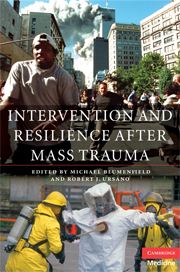Book contents
- Frontmatter
- Contents
- List of contributors
- Foreword by Joseph T. English
- Preface
- 1 Systems, science, and populations: Effective early mental health intervention following mass trauma: the roles of government, clinicians, and communities
- 2 Factors in the development of community resilience to disasters
- 3 Psychological first aid
- 4 Acute stress disorder and early interventions after trauma
- 5 The role of pharmacotherapy in early interventions
- 6 Should culture considerations influence early intervention?
- 7 Resilience is the default: how not to miss it
- 8 Epilog: Early intervention for individuals and communities: planning for the future while meeting present needs
- Index
- References
3 - Psychological first aid
- Frontmatter
- Contents
- List of contributors
- Foreword by Joseph T. English
- Preface
- 1 Systems, science, and populations: Effective early mental health intervention following mass trauma: the roles of government, clinicians, and communities
- 2 Factors in the development of community resilience to disasters
- 3 Psychological first aid
- 4 Acute stress disorder and early interventions after trauma
- 5 The role of pharmacotherapy in early interventions
- 6 Should culture considerations influence early intervention?
- 7 Resilience is the default: how not to miss it
- 8 Epilog: Early intervention for individuals and communities: planning for the future while meeting present needs
- Index
- References
Summary
Introduction
The management of acute stress reactions following disasters and mass violence generally aims to foster resiliency, prevent chronic emotional problems, and minimize long-term deterioration in quality of life following the trauma exposure. Although it is widely believed by traumatic stress specialists that early intervention can help prevent longer-term problems, evidence addressing this belief is limited at present.
This chapter will review the current empirical literature on early interventions following mass violence, and describe the principles of a consensus-recommended intervention called “psychological first aid.”
Background research: effects of disasters
Researchers wishing to conduct studies on acute interventions following disaster face many methodological challenges. Early interventions typically take place in chaotic and uncontrolled settings, with little pre-planning, funding or co-ordination between researchers and interventionists, a focus on action and assistance rather than research, and cross-community barriers between local responders and external researchers. Therefore, in the absence of well-controlled intervention studies, an initial examination of the effects of disasters, as well as risk and protective factors, has often been the basis for developing interventions that foster identified protective factors and ameliorate vulnerability factors.
Rates of traumatic stress disorders and functional impairment in the general population following disaster or mass violence may be somewhat low over time, as evidenced by recent epidemiological studies following the September 11 terrorism attack in New York (Galea et al., 2002). Galea found a sharp decline in post-traumatic stress disorder (PTSD) symptoms in New York over the course of 6 months, from 7.5% to 0.6%.
- Type
- Chapter
- Information
- Intervention and Resilience after Mass Trauma , pp. 69 - 84Publisher: Cambridge University PressPrint publication year: 2000



